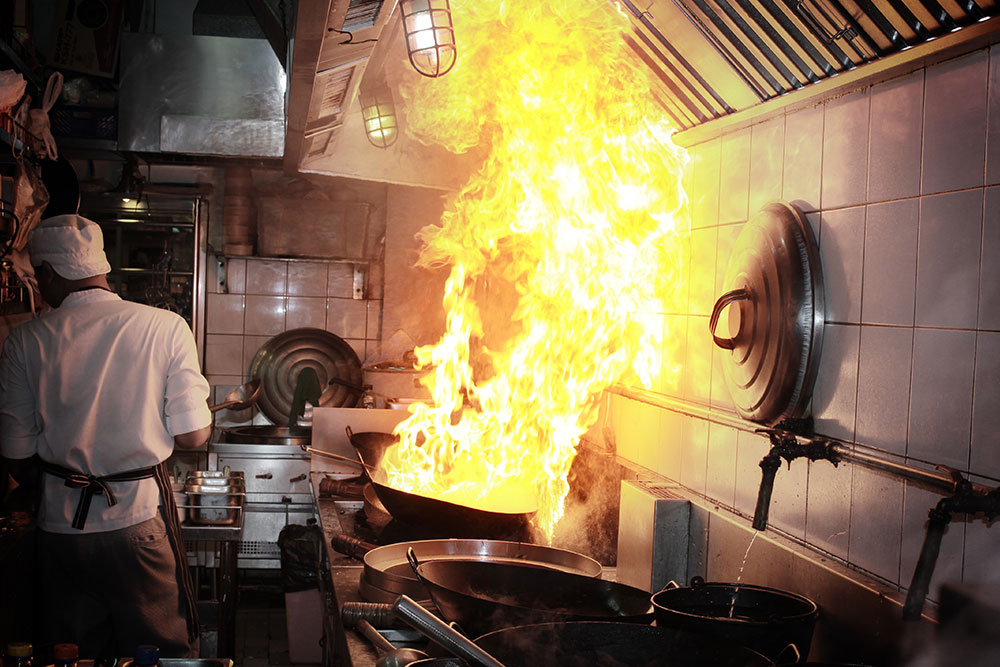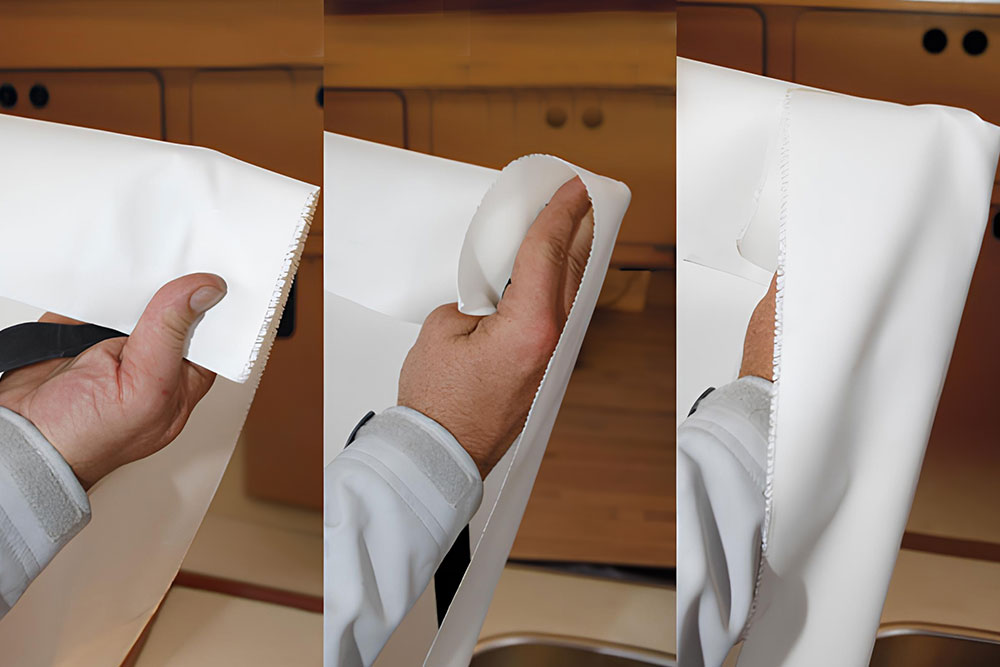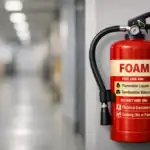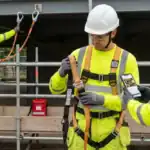
You’ve almost certainly seen fire blankets before. They’re a fixture of non-domestic kitchens (and domestic kitchens for the safety-conscious). You probably also have a good idea of when to use a fire blanket. It’s no coincidence they’re always close by when cooking.
But using one isn’t always straightforward. As with any firefighting equipment, you risk it being ineffective at best or dangerous at worst. Our guide explains exactly when to use a fire blanket and how to do so safely. It also covers the types available and how to select and install them in a workplace.
How Fire Blankets Work
Fires need three things to burn: heat, fuel and oxygen. These three elements make up the fire triangle. Remove one, and a fire will go out.
Fire blankets are designed to smother fires and deprive them of oxygen. They’re made of a fire-resistant material (fibreglass or nylon) that can be safely draped over a fire. When used correctly, this will contain the flames and, with enough time, extinguish the fire.
Fire blankets are intended for Class F fires, which involve burning oils and fats. Because of the extreme temperatures these fires reach, it’s unsafe to use a conventional water-based extinguisher on them.
Water that comes into contact with the burning oil will almost instantly evaporate. This high-energy reaction risks spreading the burning oil or fat on the surrounding area and the person attempting to extinguish the fire. Carbon dioxide extinguishers carry a similar risk. While the CO2 won’t react violently with the fire, it won’t sufficiently cool it either. The force of the discharge will also spread the burning oil or fat.
Fire blankets don’t carry this risk. They can be used relatively safely to extinguish a Class F fire, provided it’s still small. Because fire blankets are also inexpensive and easy to use and maintain, they’re often placed in workplace or commercial kitchens.
When to Use a Fire Blanket
Fire blankets are primarily used to tackle small Class F fires. These fires often happen when cooking is left unattended and reaches a hot enough temperature to ignite. They can also occur when flammable oils are spilt close to open flames.
Noting how a fire started is important when using a fire blanket.
Fires burning on a surface can be extinguished by directly smothering them with a blanket. Examples of these types of fire include:
- Burning food in a shallow pan or baking tray.
- Burning oil spilt on a countertop/surface.
- Burning solids on a worktop.
For other Class F fires, a fire blanket alone may not be enough. For example, draping one over burning food in a saucepan may not extinguish the fire. The blanket will effectively form a ‘lid’ over the saucepan, leaving enough oxygen in the pan for the fire to continue to burn.
Using a fire blanket in these situations is still advisable, as it will contain the flames. But you may need to use an additional handheld extinguisher to put out the fire fully.

Burning Clothes
Fire blankets can also be used to put out burning clothes. If a person’s clothes catch fire, you can wrap the blanket around them to smother the flames. The person should also drop to the floor and roll until confident the fire is out.
Fire Safety Training
Our Fire Safety Training course gives a basic understanding of fire prevention principles, the sources of ignition and fuel and safe systems of work to prevent fire hazards and accidents within the work environment.
Escaping a Fire
Fire blankets can also be used when escaping a fire emergency. If you must risk passing through a burning room or corridor when evacuating, wrap the blanket around you. The fire-resistant material will offer some protection against the flames.
When Not to Use a Fire Blanket
Fire blankets are only safe to use when:
- Fire is burning over a surface smaller than the blanket.
- You can safely place a blanket over the fire.
If a fire is larger than the blanket, you won’t be able to smother the flames effectively.
If a fire is too large or hot to approach safely, do not attempt to throw the blanket over the flames. You will miss. You’ll also lose any chance to retrieve it and try again.
Using a Fire Blanket
Fire blankets are relatively straightforward to use:
- Turn off the heat source if possible and safe to do so.
- Free the blanket by pulling on the two quick-release handles.
- Unfold the blanket and hold it at the top two corners.
- Grip the corners and fold them in. Your hands should be safely behind the blanket.
- Approach the fire. Place the blanket over the entire burning area and leave it in place.
- Cut the power supply to any burning appliances.
- Contact the fire service. Leave the blanket undisturbed for at least 60 minutes or until the emergency services take over.

Selecting a Fire Blanket for Your Workplace
First, it’s necessary to determine whether a fire blanket is needed for your workplace. They’re an effective safety measure if you have a kitchen on-site, but your fire risk assessment should settle this decision.
Commercial kitchens should always have fire blankets fitted because they feature a variety of Class F fire hazards.
When selecting one, you must ensure it conforms to British Standard EN 1869. This British Standard was first developed in 1997 and updated in 2019, so look for blankets that meet the modern standard: BS EN 1869:2019.
They typically come in three sizes:
- 1.0 x 1.0 metre (around the size of a coffee table)
- 1.2 x 1.2 metre (around the size of a medium kitchen table)
- 1.2 x 1.8 metre (around the size of a double mattress)
The smallest-sized blankets are typically used in domestic kitchens, as they’re only effective against small fires, such as those in a frying pan or baking tray.
The next size up is probably more suitable for workplace kitchens.
The largest blankets are for commercial kitchens. They’re also best for smothering clothing fires, as they’ll comfortably wrap around most people.
Refer to your risk assessment to determine the best size for your workplace.
Location
You only have seconds to smother a fire before it spreads, so fire blankets must be easily accessible.
Place them in rooms where they may need to be used within 10m of the fire hazard in question. But be wary of placing them too close. If a fire breaks out, it may cut off safe access to the blanket.
Mount them on a wall around shoulder height (the quick-release handles should be about 1.5 m from the floor). This position should be in most people’s eye line and easily reachable.
If fire blankets are not immediately noticeable, you must install safety signs alerting people to their location.
Inspection
Like other firefighting equipment, fire blankets should be checked regularly. They should be removed from the container and visually inspected for signs of wear or damage. After the inspection, they should be properly packed away and left ready for use.
At a minimum, a competent person should carry out these inspections monthly. Weekly checks are strongly recommended, however.
Replacement
Fire blankets certified to BS EN 1869:2019 are single-use. If you use one in an actual fire emergency, it should be discarded and replaced as soon as possible.
Unused blankets should be replaced after seven years of service.
Key Takeaways
- Fire blankets are designed to smother fires by depriving them of oxygen and are suitable for small Class F fires involving cooking oils and fats.
- Select blankets that conform to British Standard BS EN 1869:2019 and choose the appropriate size based on your fire risk assessment.
- Fire blankets must be easily accessible as you only have seconds to smother a fire before it spreads.
- Place them near potential fire hazards but not too close to ensure safe access during an emergency.
Fire Safety Training
If you’re responsible for workplace safety, you must do much more than install a fire blanket. Your entire premises must be assessed for fire risks and equipped with adequate alarms and firefighting equipment. And you’ll need to be sure every staff member understands fire prevention and can safely evacuate in a fire emergency.
Our online Fire Safety Training equips staff with the knowledge and skills to prevent and respond to fires. It fulfils basic training requirements, covering fire prevention, evacuation procedures and extinguishing small fires.





















